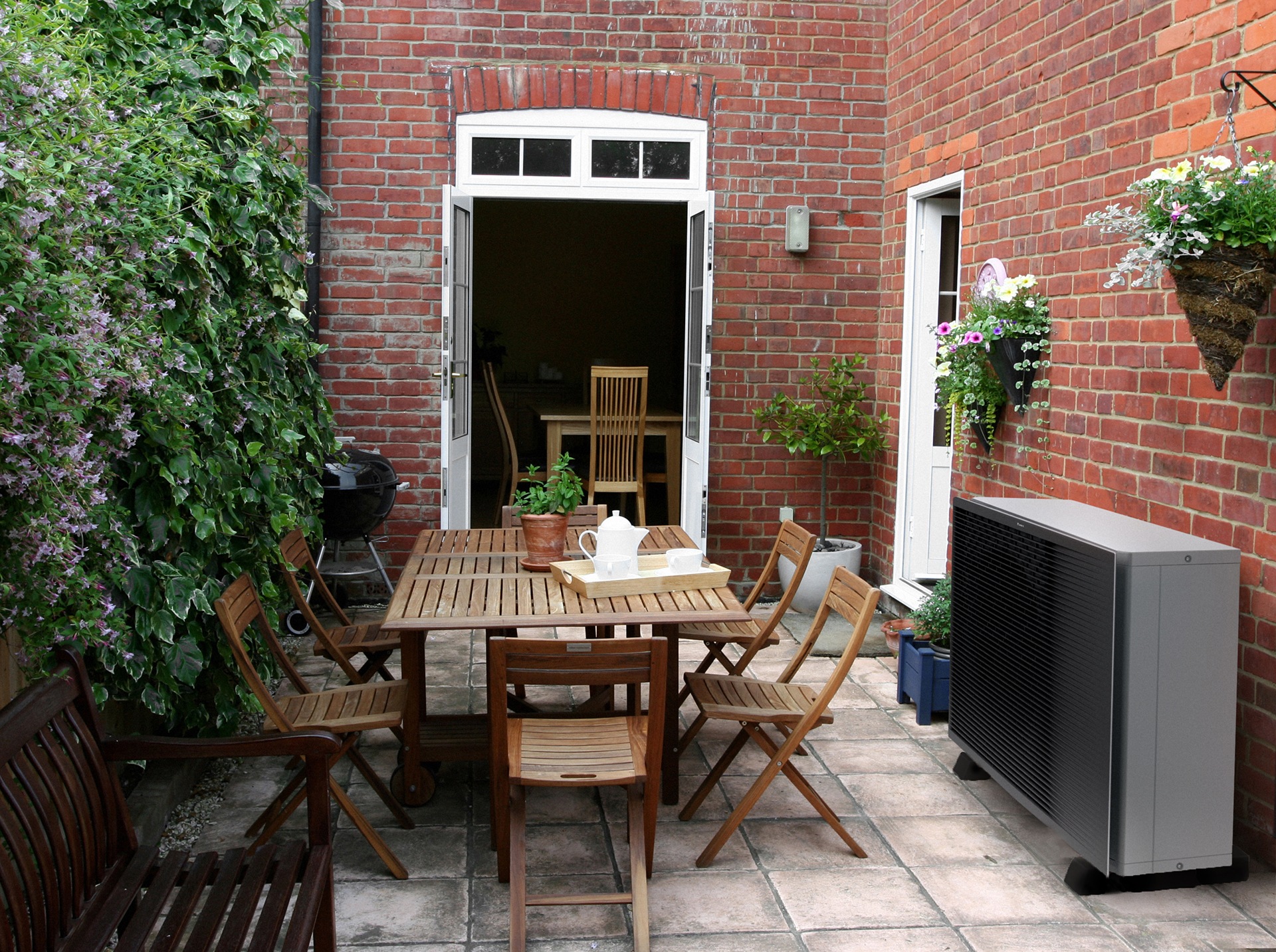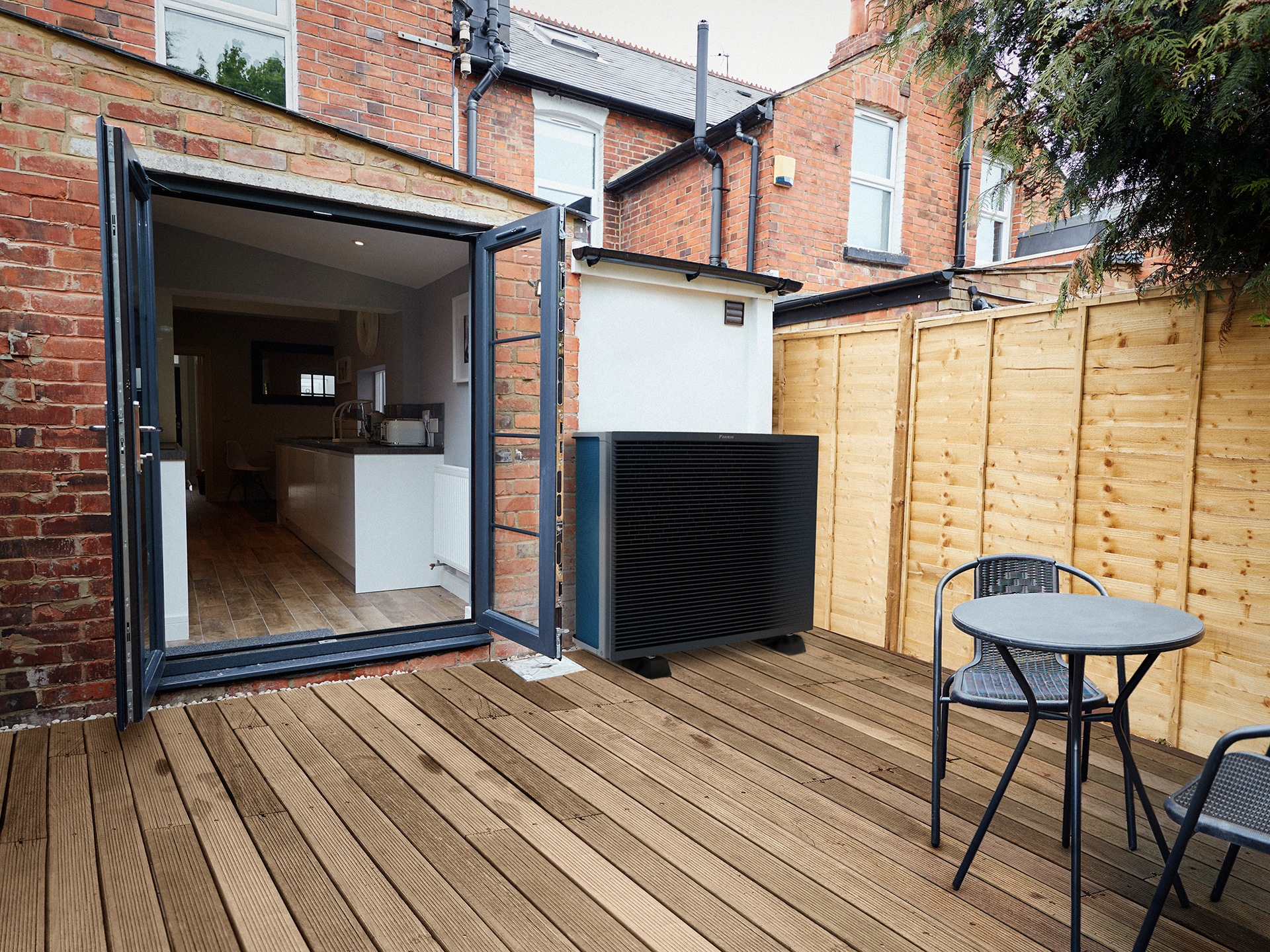High-temperature heat pumps: the solution to draughty, old British homes?
There’s a new type of heat pump on the market that might be just what’s needed to convert a sceptical British public to the low-carbon heating technology.
As the name suggests, a high-temperature heat pump is an air-source heat pump that runs with a higher flow temperature than standard heat pumps. It is designed to be able to heat the water in the heating circuit – the radiators or underfloor heating – to a higher temperature. Rebecca Armstrong, from eco-energy-solutions company Making Energy Greener, puts it like this, “A high-temperature heat pump is a renewable-energy system that has the capability to heat your home to comparable levels of warmth – and just as quickly – as a traditional gas boiler. By achieving temperatures from 60°C to 80°C, it warms your home faster than standard heat pumps, while eliminating the need for additional radiators or new insulation.”

- Image credit: iStock/Daikin
Where are high-temperature heat pumps suitable for?
Hamid Salimi, from heat-pump manufacturer Daikin, says, “We see high-temperature heat pumps as particularly suited to heating older buildings that have traditional radiators, as their adaptability makes them perfect for modernising existing central-heating systems. These heat pumps offer an efficient solution without causing significant structural modifications. Their compatibility with existing heating set-ups ensures a smooth transition to more sustainable and cost-effective heating alternatives.”
Because high-temp pumps can produce water of a similar temperature to that produced by gas, oil or LPG boilers, they are great for retrofitting, whereas standard heat pumps, which operate best at much lower flow temperatures, sometimes need to be hooked up to new, larger radiators to deliver enough heat. Conventional wisdom tells us that standard heat pumps also work best in well-insulated homes.
How do high-temperature heat pumps work?
Armstrong explains, “The secret to [high-temp heat pumps’] effectiveness lies in the use of advanced refrigerants like R290 or R32, [which are] superior to those used in low-temperature heat pumps. These choices are not only more efficient but also kinder to the environment. Additionally, cutting-edge weather compensation controls enhance performance levels.”
R290 and R32 work more efficiently at higher temperatures than the first generation of heat pump refrigerants could manage. R290 is refrigerant-grade propane (LPG) and R32 is difluoromethane. Both gases also have lower global warming potential (GWP) than some of the refrigerants used in earlier heat pumps, such as R410A and R407C. Of R32, Hamid says, “With a lower GWP, R32 achieves higher energy efficiency and lower CO2 emissions, meaning it’s the perfect solution for reducing environmental impact, and has an important role to play in decarbonising homes.”
Meanwhile, high-temp heat pumps are also usually equipped with the latest weather compensation technology, as are most modern standard heat pumps. Weather compensation adjusts the flow temperature of the heating system according to the temperature outdoors, generating only the heat required to warm a house based on the current weather. In other words, when it’s very cold, the flow temperature is raised; when it’s warmer outside, the flow temperature is reduced. This means that the heat pump only ever uses the required energy to keep your home warm, varying output day by day. Weather compensation needs to be adjusted based on your property, which is why it’s important to get a competent installer that will install the kit and tune it to your home.
Are high-temperature heat pumps available in the UK?
High-temperature heat pumps are a new development in a new technology. They are just starting to become available in this country. Models currently available include the Daikin Altherma 3 High Temperature and the Trianco Activair High Temperature Heat Pump, both available in different sizes. It is likely more models will come to market soon. For example, Vattenfall, has been talking about releasing its high-temp model in the UK for a couple of years now.

- Image credit: iStock/Daikin
How much are they?
High-temp heat pumps are more expensive than standard models. At the moment, prices are reckoned to be about 10% higher. But, if a high-temperature model means reduced retrofitting costs – say, because radiators don’t need to be ripped out and replaced, and difficult-to-fit extra insulation avoided – that might leave the high-temp pump looking like a good choice. High-temp air-source heat pumps can qualify for grants of up to £7,500 under the government’s Boiler Upgrade Scheme.
What about running costs?
Previously high-temp heat pumps seemed like a bad idea because they required extra electricity to get the water flow temperature to higher levels. And, as electricity is already more expensive than gas, this looked like a bad option in terms of running costs – not to mention being a negative for what is meant to be a low-carbon heating choice.
However, the efficiency of high-temperature heat pumps has improved such that they can now achieve similar coefficients of performance (CoP) to standard heat pumps. And this means their running costs can be very similar to standard models.
As the unit cost of electricity per kWh is about four times that of gas, heat pumps generally cost a little more to run than gas boilers on standard tariffs. Factor in solar panels and time-of-use smart tariffs, and that picture can change. If you are currently using oil or LPG to heat your home, meanwhile, a well-designed and installed heat pump system of any kind should save you money.
There are lots of factors that will affect the running costs of any heat-pump system, including:
- your electricity tariff
- the type of heat pump you install and how efficient it is (its CoP)
- your location and its average air (or ground) temperatures throughout the year
- how well your house is insulated
- how well your heat-pump system is designed and installed

- Image credit: iStock/Daikin
High-temp vs standard heat pump
Zoe Phillips, of Cotswold Energy Group, reminds us that conventional heat pumps work very well in many homes. She says, “While heat pumps work best in well-insulated homes, they can still be an effective and efficient method of heating for less well-insulated homes. In fact, the operational efficiency of heat pumps – with a CoP typically ranging from three to five [300-500% efficiency] – surpasses that of any traditional heating system. This efficiency translates into significant cost savings for homeowners, with potential annual savings of over 70% compared to direct electric heaters, around 40-50% against oil and LPG and up to 10% against gas, depending on your tariff. Moreover, heat pumps significantly reduce carbon emissions, making them a more sustainable choice for environmentally conscious individuals.
“These efficiencies and savings are dictated by the heat-pump design, specifically the flow temperature achieved around the heating circuit (radiators or underfloor heating). The best installers will always strive for the lowest flow temperature possible. But, in some instances, building conditions and/or emitter (radiator) restrictions aren’t conducive to a low-temperature design. This is where high-temperature heat pumps come in. They are able to mimic a traditional fossil-fuel system in the sense they can achieve higher flow temperatures, so can be installed with less retrofit requirements, whilst still removing fossil fuel use from a property.”
Part of the reason high-temp heat pump models work really efficiently is simply that they are newer models, and the technology has moved on since the first generation of heat pumps was designed and made. So, as we explained above, high-temp heat pumps use different refrigerants and also incorporate weather compensation. This is a young technology, and through evaluation projects such as the government’s Electrification of Heat Demonstration Project, scientists and engineers are learning all the time how to get the best out of it.
Armstrong says, “I firmly believe high-temperature heat pumps stand out for specific scenarios, particularly when retrofitting existing properties where selecting an energy-efficient option tailored to the property is crucial. However, I would like to highlight several things:
- insulation: it plays a vital role in retaining indoor temperature by preventing heat loss through walls, lofts, and windows. If possible, insulation should always be prioritised
- energy-saving habits: wearing appropriate clothing such as jumpers, slippers, and warmer attire during winter helps us maintain a comfortable temperature without excessive heating, ideally around 21°C, making high heat often unnecessary
- cost consideration: initially, high-temperature heat pumps are pricier compared to standard air source heat pumps. Coupled with the higher cost of electricity over gas, users transitioning from an efficient gas boiler might witness increased electricity bills if not offset by solar-power generation.”

- Image credit:iStock/Daikin
Interestingly, recent government research showed that, in use, high-temp heat pumps were seldom used at much greater temperatures than standard heat pumps – at a flow temperature of over 65°C less than 1% of the time, in fact. This may seem somewhat counterintuitive, but heating systems are specified in a way that they’ll heat your home in the worst-case scenario. As the stats show, high-temp heat pumps don’t constantly need to run at their maximum output, and often run at flow temperatures similar to those of standard heat pumps, boosting to maximum output only when it’s truly required.
Nonetheless, as Philips says, “The option to be able to install either low- or high-temperature heat pump will help diversify the reach of heat pumps, creating solutions for the most bespoke of cases; and meaning heat pumps can, therefore, be a compelling option for any homeowner seeking to reduce their energy bills and carbon footprint.”









